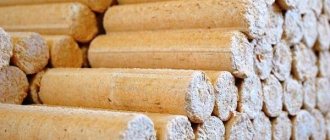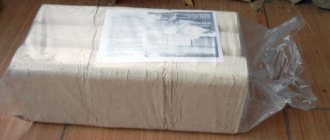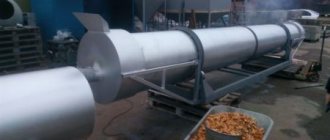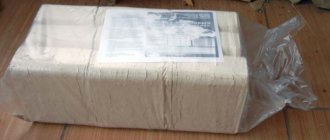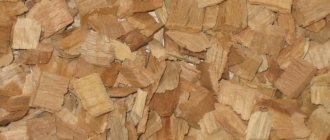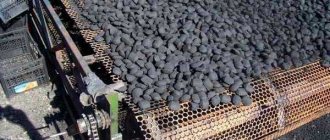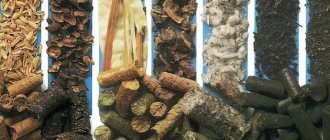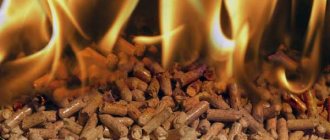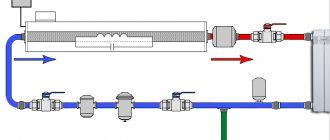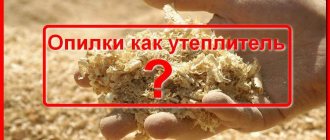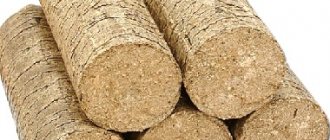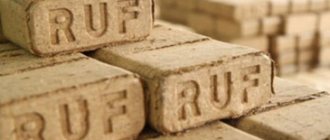Concern for the environment and careful use of natural resources have led to emergence of a new type of fuel – sawdust briquettes or, as they are also called, Euro-firewood.
Their specific gravity and calorific value at the same moisture content are slightly higher than that of the original wood.
In addition, briquettes are easy to store as they take up little space.
Next we will tell you:
- what are sawdust briquettes?
- how they differ from firewood and other types of fuel;
- how to heat stoves and boilers with them;
- how to make them industrially and independently;
- how to make a business producing and selling this fuel.
What it is?
Sawdust briquettes are logs of various shapes made from compressed sawdust.
In most cases, the following forms are popular :
- rectangular parallelepiped (RUF - after the name of the company that first launched their production);
- a hexagonal column with a hole along the entire length (Pini-Kay, Pini&Kay - after the name of the company that first launched their production);
- square post with or without hole;
- round log (Nestro).
Differences from other fuels
The shape does not affect the calorific value or combustion behavior of sawdust briquettes, but may affect the efficiency of the automatic loading device. After all, this is precisely the main advantage of such fuel over wood and coal.
Due to the same shape and size, briquettes are ideal for use in boilers and furnaces with automatic fuel loading.
The only condition is to select the fuel in such a shape that it matches the loading device.
The combustion mode of briquettes fully corresponds to the combustion mode of wood or coal - heated fuel decomposes into pyrolysis gases, which mix with oxygen and ignite.
However, their structure is closer to coal.
Indeed, unlike wood of any species, they do not have capillaries that penetrate the entire product, therefore, at the same temperature, decomposition into ash and pyrolysis gases occurs a little more slowly.
Like firewood, the combustion mode and calorific value of the briquettes are affected by the humidity of the briquettes, so it is very important to buy not only high-quality products, but also those packaged in plastic film, which protects the fuel from precipitation.
In addition, it is important to store fuel in a well-ventilated area, protected from rain and sun.
Pros and cons of using fuel briquettes
The advantages of the new fuel are clearly revealed when it is compared with classic firewood. First, it’s worth discussing the benefits received:
- High calorific value. When burning, pressed sawdust releases 2–3 times more heat per unit weight.
- Increased burning time. Compared to ordinary wood, fuel briquettes last 1.5–2 times longer, which, coupled with the first advantage, allows you to save on heating.
- Environmentally friendly and harmless. No chemical reagents are used during creation; the production of European firewood itself utilizes part of the waste from wood processing factories.
- Low resin release. The chimney needs to be cleaned 2 times less often than when burning wood.
- Less noise, smoke and embers flying to the sides. Sawdust briquettes burn evenly, less smoke is released during the process, and after that there is not as much ash left as from ordinary firewood.
- Ease of storage and use. The shape of the briquettes allows for a minimum of space for storing them, and it is also optimally suited for use in boilers with automatic fuel supply.
- High density. This means that with the same volume, the mass of fuel will be on average 3 times higher than that of firewood. Convenient for transportation, the truck will transport more payload at a time.
- Low moisture content. Such sawdust fuel has a moisture content of about 10%, while dry firewood has a moisture content in the range of 20 to 25%. Euro-firewood has less useless water in weight, and less heat is used to evaporate it.
Comparison of Eurowood with other types of fuel
Disadvantages:
- Relatively high cost. Buying sawdust in briquettes will cost more than the same volume of firewood.
- Be afraid of interaction with water. When storing, it is necessary to ensure that fuel blocks are protected from moisture.
- Limited shelf life. Some manufacturers indicate a maximum shelf life of 1–3 years. During this period, fuel must be used;
- Distribution problems. In some regions, compressed sawdust is not used for heating due to the lack of a supplier.
- Fragility. Fuel briquettes are not very durable and can crumble under mechanical stress, especially for low-quality products, which, unfortunately, are now widely represented on the market.
- The smell is from ash. Ash from burnt fuel briquettes has an unpleasant, tart odor.
- No clicking. For some, this may be a disadvantage, because people associate this sound with warmth and comfort, it’s just a psychological feature.
The use of long-burning furnaces and boilers will increase the economic effect of using fuel blocks by approximately 2 times. It is possible to provide a burning time of more than 12 hours with one load of fuel. From here it became possible to smoothly move on to the next question: “How to properly heat with pressed sawdust?”
How to properly heat with pressed sawdust?
When heating conventional stoves, fireplaces and boilers, sawdust briquettes are used in the same way as ordinary firewood , following the instructions for the heating device. In fireplaces and brick stoves, the heating time should not exceed two hours, otherwise the masonry will begin to deteriorate.
If you use fuel made from softwood or with a high bark content, you will need to clean the chimney more often. After all, such fuel contains a lot of resins, which form volatile compounds that settle on the walls of chimneys.
Often, homeowners with brick wood-burning stoves set them to smoldering mode, which allows hot smoke to move through the chimney all night, ensuring it is heated and the room is at a comfortable temperature.
In this mode, the burning time of briquettes is much higher than the burning time of firewood, so one bookmark is enough for the whole night. But in this mode, chimneys and chimneys become clogged much faster, so they need to be cleaned twice a year.
Read more about how to heat stoves, fireplaces and boilers with this type of fuel here. We also recommend reading an article on how to choose an automatic boiler or burner for briquettes or pellets.
Home method
Of course, purchasing powerful professional equipment for home use does not make sense.
The cost of such a unit will only pay off if compressed firewood is produced for sale. Unfortunately, it will not be possible to adhere to the standard technology in which lignin is isolated. We recommend: Do-it-yourself stove for burning garbage at your dacha. You can replace wood processing waste with tree branches after winter pruning .
Before pressing, they must be crushed with a crusher. You can also use materials that burn well, for example, straw, paper, seed husks.
Home craftsmen have figured out how to form briquettes without a natural binder. Instead of lignin, they often use:
- Clay.
- Wallpaper glue.
- Paper and cardboard.
Craftsmen were able to bypass the lack of a briquetting press for sawdust . The raw materials are soaked in water and then mixed in clay. It is important to adhere to the proportion of 1:10. If there is no clay, add soaked paper or glue. The prepared material is sent to a homemade briquetting unit and pressed using manual force. The resulting briquettes are removed from the press and sent to dry in fresh air.
Production
The production of briquettes is based on one feature of sawdust: after compression, lignin, which is a mixture of aromatic polymers, is released from them.
Lignin glues all sawdust particles together, turning them into a durable monolithic product.
Depending on the manufacturing method, humidity should be 6–12% and pressure 300–1000 kg/cm2.
Because of these requirements, when making this type of fuel at home, you have to resort to various tricks, replacing lignin with other binders, among which the most popular are:
- wallpaper glue;
- manure;
- clay.
Industrial manufacturing
Sawdust is carefully sorted to prevent diseased wood or bark from getting into the working material. Then it is dried using various installations, bringing it to the required humidity.
After this, the dry material is fed into special presses or extruders, which create the necessary pressure and give future briquettes the desired shape.
Due to the high pressure, the sawdust briquette heats up to several hundred degrees, causing its outer part to be slightly charred. This is one of the signs of properly made Eurowood.
Sometimes, after pressing, the blanks are sent to the furnace to undergo additional heat treatment, which increases the calorific value of the fuel.
To give the mass of sawdust the desired shape, both traditional hydraulic presses, which are characterized by low productivity, and screw devices are used.
The advantage of hydraulic presses is that they can simultaneously produce several briquettes.
In addition, only hydraulic devices can make rectangular Euro firewood.
Impact presses are sometimes used , but they are less efficient and more difficult to operate.
In addition, impact technology is poorly suited for working as part of automatic or semi-automatic lines.
We have prepared links to some models of presses that are used for industrial sawdust briquetting:
- Impact-mechanical presses series PBU-070-800 briquette with hole.
- Equipment for the production of fuel briquettes "Eco firewood".
- Line for the production of fuel briquettes 400 kg per hour.
Such presses provide sufficient pressure to separate lignin, but are expensive, so they are used only for industrial production in large volumes.
Another distinctive feature of industrially produced briquettes is their high specific gravity, which is 10–20% higher than that of the original wood.
During the processing process, sawdust is delivered from device to device using conveyors (movers) of various models and types.
Read more about all the installations that are used in such operations here and here.
Home pressing method
The main problem that arises when making this type of fuel from sawdust at home is that lignin is released at very high pressure, which is difficult to provide with homemade devices.
Therefore, it is necessary to make either low-performance devices based on hydraulic or screw jacks, or use various binders that can replace lignin.
In addition to the jack, which acts as a press, you also need a matrix and a punch, which will give the future briquette a certain shape. You can also use homemade extruders based on a screw, but they are much more difficult to make.
There are other types of devices.
How to make a press from a hydraulic bottle jack?
The easiest way is to use a car bottle jack with any stroke. The jack pressure must be determined using the formula P=S*K, where:
- P – pressure in tons;
- S – briquette cross-section in cm2;
- K – coefficient indicating the required pressure in tons per cm2 or (kg*cm2)/1000. The optimal value is 0.5–1.
According to this formula, to produce a round briquette with a diameter of 8 cm, you will need a jack with a force of 25–50 tons. To make a briquette with a diameter of 5 cm, you will need a jack with a force of 10–20 tons.
If you have found a suitable jack, then you will need:
- a seamless pipe with an internal diameter equal to the outer diameter of the future briquette and a wall thickness of 8–15 mm, which you will use as a matrix;
- a steel rod, the outer diameter of which is 0.05–0.08 mm less than the inner diameter of the pipe, it will act as a punch;
- steel channel 5–8 mm thick;
- M8 bolts and nuts, the length of which is 2–3 cm longer than the width of the channel (short bolts can also be used, but this is less convenient;
- steel strips of various lengths, widths and thicknesses;
- steel plate measuring 50x50 cm and thickness 3–5 cm.
First you need to determine the length of the future briquette, which is undesirable to make greater than 1.5 times the stroke length of the jack rod.
Then the length of the pipe is determined by adding the length of the briquette and the double stroke of the rod. The length of the rod is made equal to the stroke of the rod, multiplied by 2.
The pipe and rod will have to be made to order from a turner, because it is almost impossible to select parts with such a gap.
After this, find the height between the upper and lower channel beams, for which they add:
- pipe length;
- stroke of the jack rod;
- jack height.
Add 1–2 cm of margin to the resulting value. The distance between the vertical channels is made equal to the width of the base of the jack plus 1 cm.
Then a rectangular structure that meets these requirements is made from the channel, and its lower part is attached to the slab.
The joints between the channels are secured with bolts.
If you decide to make a welded structure, then you need to install amplifiers at each corner.
After all, the tensile strength of the seam is less than the force created by the jack.
the finished structure to a metal plate.
Guides need to be welded to the top of the structure, which would fix the pipe and prevent it from moving to the sides. The guides can be of any shape.
You can also use a steel ring as a guide, the inner diameter of which is 0.5–1 mm larger than the outer diameter of the pipe.
Secure the jack with bolts so that there is no play.
Approximately in the middle, it is necessary to attach guides from channels, and one guide must be rigidly fixed, and the other must be equipped with a hinge on one side and a lock on the other.
The guides should prevent the pipe from moving in any direction, but not compress it. Without such fixation, you will not be able to create the necessary pressure. In addition, due to the distortion, the rod will jam in the pipe and you will not be able to pull it out.
Having assembled the structure, carry out a trial production of the briquette. To do this, insert the rod halfway into the pipe and fill the pipe tightly with sawdust. Install the rod and filled pipe into the structure, fix and lift the jack rod until serious force is exerted.
Then make a mark on the rod that corresponds to the bottom edge of the pipe, lower the jack, release the side guide and pull the pipe out.
Knock the briquette out of it and inspect it.
If the log turns out to be hard, smooth and durable, then lightly hit it on the table .
If it survived the impact and did not fall apart, the pressure was sufficient to release lignin.
If it falls apart, then repeat the entire procedure with new sawdust, but adding a few more pumps with the jack lever, and then check the quality of the product again.
Construction of an installation from other elements
The only difference is in the method of attaching the jack, so first determine how it is most convenient to install and fix it. Then calculate the frame from the channels, assemble it and conduct trial tests. Remember, there are two main conditions:
- rigid fixation of the pipe with the rod;
- rigid fixation of the jack.
The absence of rigid fixation of any of the elements will lead to its distortion and damage to the pipe and rod, and they are the most expensive parts of this structure.
As a source of pressure, you can use any jacks that can create the required force.
If instead of a jack you decide to use a hydraulic pump and a hydraulic cylinder, then the general principle remains the same: rigid fixation of all parts and the ability to remove and install the pipe only after tilting the side clamp.
What to do if the press effort is not enough?
In this case, it is necessary to load not pure sawdust into the press, but a mixture of wood sawing waste with any binder, and the proportions must be selected individually.
The most suitable type of binder is manure or droppings.
After mixing and pressing the briquette, it must be thoroughly dried.
Drying time depends on the initial humidity, air temperature and other factors, so it will have to be selected individually.
However, such fuel has a low calorific value and high ash content, so it is undesirable to use it in boilers and furnaces with automatic feed.
Making briquettes yourself
When making briquettes from sawdust on an industrial scale, a natural adhesive material, lignin, is released from them, which acts as glue and makes the product a monolith. At home, it is impossible to achieve such density with homemade devices using improvised means, and therefore additional components must be added when pressing. These particularly popular binders include:
- wallpaper glue;
- manure;
- clay.
The moisture content of the original wood should be below 12%, and the amount of damaged and unusable sawdust should be 5%.
Selection of raw materials and their preparation
To create such pressed fuel with your own hands, you should choose high-quality material. The basic ones are:
- sawdust;
- shavings after processing agricultural crops;
- waste paper;
- straw;
- secondary raw materials from coal and peat.
The total share of wood chips when choosing a combined composition of raw materials should not be lower than 60%. In this case, high quality combustion of the briquette is ensured.
Homemade pressing installations
Homemade sawdust making machines can be divided into the following types:
- manual;
- based on jacks;
- hydraulic.
To achieve lignin production, devices based on a lifting mechanism (hydraulic or screw type) can be used. Their main disadvantage is low performance.
In addition to the jack, which serves as a press, the machine uses a matrix and a punch. They give the finished firewood a certain shape. A DIY screw extruder simplifies the task of producing compressed fuel, but it is also much more difficult to make.
Stationary press for creating fuel
You can make a press for briquettes if you have the following spare parts:
- motor;
- bearings;
- gearbox;
- shaft;
- screw;
- heating elements;
- relay for temperature control.
If the voltage consists of three phases, then a 9 kW motor is used, and if work is to be done from a standard 220 V network, then a motor with a power of 2.5 kW will be needed. It, together with the gearbox and other components, is mounted on a welded frame.
In this installation, the auger is a special design of two components, one of which acts as a punch, and the other delivers sawdust into a specialized container for loading. The matrix is replaced by a profile pipe.
Before starting a homemade machine, the pipe should be heated to 260 °C, and the heating process of the heating elements is regulated using a relay. The disadvantage of this design is the large coefficient of heat loss into the air.
Briquette manufacturing technology
The procedure for making briquettes with your own hands is divided into several successive processes:
- Preparatory processes for raw materials and their purification.
- Grinding sawdust to a caliber of less than 0.6 cm.
- Pressing.
- Drying.
- Warehousing.
After the shavings have gone through all the preparatory processes, they are mixed with clay powder in a ratio of 10:1. Then the mass is mixed by adding a small amount of water. The mixture should be of medium thickness to hold its shape.
It is unloaded into a bunker for further briquette formation. After everything, all that remains is to dry the finished firewood.
You can artificially increase the flammability of pressed fuel by adding a little cardboard soaked in liquid to the clay.
Recommendations
Fuel briquettes are superior to firewood in terms of calorific value, but heating with them will be economically justified only in two cases:
- free sawdust in the right quantity;
- automatic fuel supply system to the heating device.
If at least one of these requirements is not met, then briquettes will not have any real advantage over firewood.
After all, they cost significantly more than firewood, and the difference in price is much greater than the difference in calorific value.
They can be made in small quantities to impress the neighbors, but you can completely switch to heating with briquettes only if both requirements are met.
Only in this case the total cost of heating costs be at least somehow comparable to the cost of purchasing firewood.
What is more profitable – firewood or briquettes?
Since price is one of the most exciting characteristics for the end consumer, the review should begin with it. 1 m3 of fuel in briquettes costs approximately 2 times more than firewood. However, the cost can vary even more depending on the quality of the compressed sawdust and the type of wood of the logs. Throughout the analysis, average indicators for both types of solid fuel will be compared.
Euro firewood burns 2 times longer, so its weight consumption is significantly lower. So far it turns out that economically there is no difference - they cost 2 times more and last 2 times longer.
Fuel briquettes give a uniform, calm flame over the entire period of time, with firewood everything is different, at first they flare up in a large beautiful fire, releasing a large amount of heat, then it dies out, and a person sees coals with rare tongues of flame. From this we can conclude that compressed fuel is better suited for heating; it provides constant, stable heat. The advantages of firewood are fast combustion and a visually more pleasant fire, especially at the beginning of use.
At the end of the fire, a lot of coals and ash remain from the firewood in the stove, and the eurowood burns out almost completely. The ease of servicing heating equipment with fuel briquettes is much higher.
Among the pressed sawdust sold on the market, a significant proportion does not meet high quality standards, has a lower density and is too easy to crumble. But even with firewood, everything greatly depends on the supplier; they are often shipped to the buyer raw, with a humidity of up to 50% and from a different type of wood. One - one, low-quality goods can be bought both there and there with approximately equal probability.
Comfort when using briquettes is definitely higher. No need to chop or dry the wood. When stored, Euro firewood takes up much less space and can carry a larger amount of fuel at a time.
Taking into account all that has been said, fuel briquettes really turn out to be a little more profitable than their natural counterparts. This is especially evident in heating systems with coolants and automatic supply of fuel to the combustion chamber.
Production for sale
To make briquettes for sale profitable, you need to find not only free raw materials nearby , but also markets.
In addition, it is advisable to purchase equipment without resorting to a loan, so at first you can take a used line.
It will cost 2-3 times cheaper than a new one.
The cost of such a used line is 1–4 million rubles, depending on performance and condition.
It includes all the necessary equipment, that is:
- press or extruder, depending on the type of briquettes;
- dryer;
- sawdust hopper;
- cyclone filter;
- Remote Control;
- conveyor.
For the production of briquettes, no special permit or license is required, however, it is necessary to obtain a sanitary and epidemiological certificate confirming the safety of transported and purchased sawdust.
This requirement was put forward by Rospotrebnadzor in order No. 776 dated November 21, 2005.
In addition, it is necessary to register an enterprise or register as an individual entrepreneur with the tax office, and also choose a form of taxation.
After this, you need to buy or rent a plot of land on which you will need to build all the necessary buildings. You can also find a site with ready-made buildings, which may be in good condition or require repairs.
Among other things, you will need workers, including:
- technologist;
- equipment setup specialist;
- accountant;
- driver;
- a loader with documents allowing him to operate a forklift;
- slinger;
- crane operator;
- workers.
After making fuel from sawdust, you will have to not only store it, but also immediately pack it in plastic film, which will protect the briquettes from moisture accumulation.
Therefore, it is necessary to provide space for both packaging and storage of products ready for shipment.
And given that large buyers take a batch of several tens of cubic meters, the size of the room must be appropriate.
To search for places of sale, you can use any media and conduct advertising campaigns on them.
Advertising in newspapers, radio and especially television is expensive, so for starters you can get by with advertising on such Internet platforms as:
- Avito.
- Flagma.
- Yandex Market.
- Regmarkets.
- Price pulse.
- Yula.
In addition, publishing advertisements on social networks will also be useful.
Another way to find a buyer for sawdust fuel is by posting advertisements on poles and notice boards.
This action will have the maximum effect in villages where there are many farmers, because the standard of living there is quite high, and gas is not always available everywhere.
Therefore, there is a high probability that someone will want to heat their house with European wood.
Oriented Strand Boards
Oriented strand board is a modern material used in construction and finishing. It consists of about 90% wood in the form of shavings and chips, bound together with waterproof synthetic resins. Each slab is formed by three or four layers of chips pressed under high temperatures and pressure, the length of which reaches 15 cm. The peculiarity of the material is that the direction of the chips in each layer is different, this allows the slabs to acquire special strength.
The industry produces several types of oriented strand boards:
- OSB-1 has low moisture resistance and strength. They are used for interior work and for furniture production.
- OSB-2 is characterized by low moisture resistance and high strength. They have proven themselves well as floors, load-bearing structures and internal partitions.
- OSB-3 is characterized by high moisture resistance and the same strength, therefore it is optimal for outdoor work.
- OSB-4 has high moisture resistance and ultra-high strength, which allows them to be used as load-bearing elements, roofs and walls.
In addition, oriented strand boards with a laminated or varnished surface are produced, which are indispensable, for example, for the repeated production of formwork. Slabs with tongue-and-groove joints applied to the ends on two or four sides are also produced.
The main advantages of OSB are:
- High strength and resistance to all kinds of damage, due to the design features of the material.
- Long service life, more than 50 years, provided that tightness is maintained.
- Easy to install and handle. The relatively light weight of the slabs allows you to do without additional equipment when installing them on the roof or walls. The material is easy to saw, drill, etc. Chips, cracks and unevenness are practically not formed.
- Good resistance to various biological influences and air humidity.
- Affordable price.
- Provide good sound insulation and heat retention.
- The large sheet format allows the construction of a structure with a minimum number of joints.
The main disadvantage of the material is the presence of toxic substances in its composition. To avoid troubles when purchasing, you should check the environmental class of the board and never use OSB intended for outdoor use for purposes other than its intended purpose. In addition, the slabs are flammable and require preparatory measures before decorative finishing. If there is no tightness, they can begin to absorb water and swell, as a result of which the structure becomes deformed and loses its strength characteristics.
Oriented strand boards are used for cladding ceilings, walls and floors, arranging stairs and floors, producing sandwich panels, constructing frame houses, and covering roofs. They are used when carrying out auxiliary work, such as installation of scaffolding, formwork, etc., for the construction of auxiliary buildings, fences, street structures and in the form of structural elements of furniture. The cost of material from European manufacturers starts from 800 rubles. per sheet.
